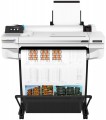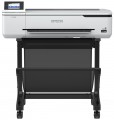Sheet printing time
Approximate time taken by the plotter to print one sheet.
This indicates for the paper size that the machine was originally designed for (see "Paper Size"). And it is approximate because it is usually given for optimal or almost optimal printing conditions: low quality and resolution, relatively simple images, etc. So the actual print time of the sheet may differ from the claimed one in one direction or another, depending on the operating parameters — starting from the mentioned quality and resolution to the type of media. However, according to the figures indicated in the specs, it is quite possible to evaluate different models and compare them with each other: the difference in the claimed time, usually, will proportionally correspond to the difference in the actual printing speed.
It is also worth noting that this time is usually indicated by the duration of the printing process itself — from the capture of the sheet by the feeder to the output of the completed print from the device. Interruptions inevitably occur between printing individual sheets, so that the total printing time is longer than the printing time of a sheet multiplied by the number of sheets. For example, a device with a time consumption of 36 sec per sheet theoretically should print about 100 sheets per hour (1 h = 3600 s, 3600/36 = 100), but in fact such a plotter usually produces about 70 – 75 sheets in this time.
Drop volume
The smallest drop volume of ink that can be produced by the printhead of an inkjet or similar plotter (see "Product Type").
This parameter is directly related to the print resolution (see “Maximum resolution”): the more dots per inch, the smaller the separate dots and, accordingly, the drops should be. At the same time, models with the same dpi number may differ slightly in this parameter. In such cases, it should be assumed that a smaller droplet volume potentially provides better print quality, with more accurate reproduction of fine lines and borders between individual areas of the image, however, such features accordingly affect the price of the device.
Max. roll diameter
The largest roll diameter that can be installed in a plotter with roll printing (see above). This parameter is useful primarily for the selection of media: the material of the same width can be produced in rolls of different diameters.
Paper grammage (min)
The lowest grammage of paper that the plotter can print normally on. Grammage is expressed in grams per square metre; accordingly, the more dense the paper, the thicker it is, and the greater the difference between the minimum and maximum paper grammage, the greater the range of materials the plotter can operate with.
The use of materials that are too thin can lead to a number of troubles: multi-sheet picking, creasing, jamming, etc. Therefore, if you plan to use low-grammage paper, you should pay special attention to this characteristic.
Paper grammage (max)
The highest paper grammage that the plotter can handle normally. For details about grammage, see "Paper grammage (Min)"; and you should pay attention to its maximum value if you plan to use thick materials. Do not try to print on more dense media than it is specified in the specs of the device: even if the plotter can handle such paper normally, it can cause serious damage.
Data transfer
Data transfer supported by the plotter.
In addition to direct
connection to a PC via USB, supported by the vast majority of such devices, connection to PC network is very popular nowadays — usually via a wired
LAN port, and often via
Wi-Fi. The last one may additionally support special modes of operation —
Wi-Fi Direct and/or
. You can also find plotters with support of external media — in the form of a card reader or its own
USB port for flash drives.
Here is a more detailed description of each of these options:
— Connection to a PC (USB). Connecting to a standard USB port on a PC or laptop is a classic data transfer format found in almost all modern plotters. It allows you to send print tasks to the device, manage settings, receive various operation notifications on your PC, save digitized materials from the built-in scanner (if available — see above), etc. The disadvantages of this connection include the fact that it is designed for interaction between the plotter and only one specific PC. Anyway, you can also manage a network sharing on this PC — but this is quite complicated; it is easier to immediately select a device with network connectivity (see below).
— Network connection (LAN)
.... LAN connection via wired LAN interface. By itself, network connectivity at least makes the plotter accessible from any PC on the local network; and some models even allow to be used over the Internet. In addition, such devices may provide various specific network functions — for example, sending materials from a scanner to file storage or e-mail. A wired connection is not as convenient as Wi-Fi — in fact, because of the need to run a wire — but it is cheaper, and it also provides a more stable and reliable connection, not dependent on obstacles and interference levels near the device.
— USB (for flash drives). USB port for connecting various external media, installed in the plotter. In addition to flash drives, this connector can be used for external HDDs, as well as for cameras and many other portable devices with built-in storage. In any case, such a connection is mainly used for direct printing — sending files for printing without using a PC. And if you have a scanner (see above), you can also copy scanned materials to an external device via the USB port. Navigation through the contents of external media is usually carried out using the display installed on the plotter.
— Card reader. Built-in memory card reader — most often SD format (although specific types and volumes of supported cards should be clarified separately, since the SD standard covers several subspecies of media). The use of this function is generally similar to the USB port for flash drives described above — it makes it possible to print files directly from external media, as well as save data received from the scanner (if available) to this media. Memory cards are now supported in many types of electronic devices — in particular, laptops are almost always equipped with card readers, and in digital cameras this type of media is used as a standard for saving footage. Accordingly, the presence of a card reader in the plotter facilitates data exchange with such equipment: removing and inserting a card is often easier than copying materials to a computer or fiddling with a direct USB connection (if it is available at all).
— WiFi. The presence of its own Wi-Fi module allows the plotter to connect to PC network, as well as use special features such as Wi-Fi Direct and Airprint. See below for such features; as for the network connection, it provides all the same features as the wired LAN standard described above. At the same time, a Wi-Fi connection is much more convenient, as it allows you to do without laying cables. True, such a connection is somewhat more expensive, besides, the data transfer rate may drop with an abundance of interference; however, for plotters, the last one is most often not critical, and the price of a Wi-Fi module is often insignificant compared to the price of the entire device. So most modern network models support not only wired, but also wireless connections.
Specifications may also specify the Wi-Fi standard used by the device; most often it is Wi-Fi 4 or Wi-Fi 5. However, the difference between these standards in this case is not fundamental: both of them provide sufficient speed for functions implemented in plotters, and modern wireless equipment usually provides compatibility with all major Wi-Fi standards .
— WiFi Direct. A feature found on models with built-in Wi-Fi modules (see above). Direct support allows you to connect other Wi-Fi devices (laptops, smartphones, cameras, etc.) to such a plotter directly, without using a router and a local network. This can be especially convenient if there is no network equipment, or if it needs to be additionally configured. The set of functions available with this connection includes, at least, sending materials to print; however, control of plotter settings and other more specific features may also be provided.
— AirPrint. Wireless direct printing technology found on Apple devices such as iPhones, iPads, MacBooks, and more. AirPrint printing is convenient and simple—it requires no additional setup when connected to a plotter and can be done with just one touch ". In this case, communication with the printing device is carried out via Wi-Fi directly — similar to the Wi-Fi Direct described above (in fact, AirPrint is usually provided as an addition to this mode).Cartridge model
Models of cartridges used in the plotter. With this info, you can easily find original consumables for the device.
Noise level
The maximum noise level produced by the plotter during operation. The lower this indicator, the less inconvenience to others the device will create. At the same time, in modern plotters, the noise level usually does not exceed 60 dB, which is comparable to a TV set at an average volume; and many of them do not "reach" even up to 50 dB, corresponding to a quiet conversation at a distance of 2-3 m. And if we also take into account the fact that plotters are usually used in industrial premises, then we can say that in most cases this indicator does not play a significant role.
Power consumption
Rated power consumption of the plotter. Usually specified by the maximum value — for the print mode, when the device requires the most power.
The heavier and more performant the device, the higher its power consumption in general. At the same time, models that are similar in performance may differ in this indicator. And here it is worth proceeding from the fact that a more energy-efficient unit usually costs more, but with intensive use, this difference can quickly pay off due to energy savings.
In addition, the power consumption may be necessary for special electrical calculations — for example, determining the necessary parameters of a voltage stabilizer, a backup generator, etc.

